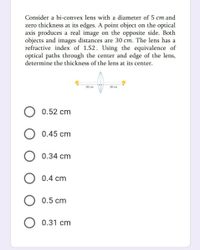Question

Transcribed Image Text:Consider a bi-convex lens with a diameter of 5 cm and
zero thickness at its edges. A point object on the optical
axis produces a real image on the opposite side. Both
objects and images distances are 30 cm. The lens has a
refractive index of 1.52. Using the equivalence of
optical paths through the center and edge of the lens,
determine the thickness of the lens at its center.
30 ст
30 ст
0.52 cm
0.45 cm
0.34 cm
O 0.4 cm
0.5 cm
0.31 cm
Expert Solution
This question has been solved!
Explore an expertly crafted, step-by-step solution for a thorough understanding of key concepts.
This is a popular solution
Trending nowThis is a popular solution!
Step by stepSolved in 4 steps with 1 images

Knowledge Booster
Similar questions
- You have a thin, diverging lens. If the value of q (the distance from the image to the mirror along the principal axis of the mirror) is -3.57cm and the distance of p (the distance from the object to the mirror along the principal axis of the mirror) is 17.16cm, what is the focal length of the diverging lens? Object Ray 1 Principal focal point Virtual image Diverging lens Ray 1 Ray 3 Ray 2 Secondary focal point |fl ·|fl· Note: Do not explicitly include units in your answer (it is understood the unit is cm). Enter only a number. If you do enter a unit, your answer will be counted wrong.arrow_forwardA lens of focal length +24.0 cm is at x 0, and a second lens of focal length -24.0 cm is located at x = 16.0 cm. Let the positive x-direction be to the right. At what position x is the final image of an object that is 48.0 cm to the left of the positive lens? cm X = What is the magnification m of the image?.(Remember that magnification can be positive or negative.) m = The image is and virtual real Where should your eye be located and directed to see the image? O looking left from the right of both lenses looking left from between the lenses looking right from between the lenses O looking right from the left of both lenses Question Source: Freedman College Physicarrow_forwardOn one side of a diverging lens of focal length 59.0 cm, you position an object of height 3.92 cm somewhere along the principal axis. The resultant image has a height of 2.74 cm. How far from the lens is the object located? 17.8 cm 25.4 cm 43.2 cm 33.0 cmarrow_forward
- An object of height 5.50 cm is placed 33.0 cm to the left of a converging lens with a focal length of 10.5 cm. Determine the image location in cm, the magnification, and the image height in cm. HINT (a) the image location in cm cm (b) the magnification (c) the image height in cm cm (d) Is the image real or virtual? O real virtual (e) Is the image upright or inverted? O upright O invertedarrow_forwardCompute the focal length of a diverging thin lens made of flint glass, whose refractive index is 1.66 and is immersed in air having refractive index 1. The radii of the spherical surfaces of the lens are 10 cm and 20 cm. Select one: O -30 cm O O -10 cm 30 cm 10 cmarrow_forwardA contact lens is made of plastic with an index of refraction of 1.40. The lens has an outer radius of curvature of +1.92 cm and an inner radius of curvature of +2.47 cm. What is the focal length of the lens? cmarrow_forward
- A 3 cm tall object is placed 2 cm to the left of a converging lens that has a focal length with a magnitude of 4 cm. A diverging lens with a focal length of magnitude 8 cm is placed 10 cm to the right of the first lens. What is the magnification of the final image produced by these two lenses? Make sure you say whether it is bigger/smaller and upright/inverted.arrow_forwardA man standing 1.54 m in front of a shaving mirror produces an inverted image 18.6 cm in front of it. How close to the mirror should he stand if he wants to form an upright image of his chin that is twice the chin's actual size? cm A contact lens is made of plastic with an index of refraction of 1.40. The lens has an outer radius of curvature of +1.92 cm and an inner radius of curvature of +2.47 cm. What is the focal length of the lens? cmarrow_forwardThe object is located at a distance of 20 cm from the lens, which forms upright image double of the size of the object. What is the focal distance of the lens? O- 5 cm O +0.4 m 10 cm O +20 cm O-0.2 m O-40 cmarrow_forward
arrow_back_ios
arrow_forward_ios